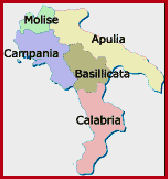|

|
In the Southern Regions, five in
total, there is neither the production, nor the variety as in other regions
although winemaking can be traced back to ancient times, with the wines
produced here acclaiming some of the most potent of Italian wines. This is
becase these regions are either heavily forested or consist of very rugged
terrain ensuring the unique quality of wines these Southern Regions produce.
|
Molise ~
in this northern part of the Southern Region agriculture is of prime
importance. Here is found dense woods with an emphasis on the cultivation of
vegetables, cereals and forage crops, where the grape is now coming into its
own rising to the head of the food chain. Just seven wines are produced here:
three reds, two rosés, and two whites with the promise of brighter days for
viticulture.
Campania
~ although there is no great emphasis placed on vineyards here as in other
areas in this region, there is a small even number between reds and whites,
with several red and white Spumantes.
Apulia
or "Puglia" which is the official Italian name ~ is in
what Italians call the "heel" of Italy's boot and is the furthest east of any
region in Italy. The difference between Puglia and it's neighbours is that
there are practically no mountains here and the terrain is mostly plain.
Winemaking here is what my Pugliese friends call their economic "pillar" and
it is a highly-regarded industry throughout Italy because of the number of
vineyards as well as the great production. As Italy is steeped in history and
Italians certainly know theirs, it was the Phoenicians who originally
colonized this region, bringing with them their winemaking skills. The Greeks
who followed were key players in the spread of wine growing and wine making
through trade and invasion and recognized this emerging trend and skill of the
people at winemaking, thereby proceeding to name the area Enotria (the
land of wine) which is a corruption of Oenotria - the Ancient Greek
name for what is now Italy. This area produces a varied selection of
well-known reds including Sanservo, Castel del Monte, Torre Quarto, Rivera
rosés and Salento dessert wines.
Basilicata
also known as Lucania ~ a very rugged area where again as in
many other areas, winemaking dates back centuries. Historical sources have
revealed this area of the Southern Region as one of the first places in Italy
where grape farming took root. Only four wines claim the fame of this region
and they are all red while connoisseurs are now beginning to appreciate the
influence of the transplanted Greek vine.
Calabria
formerly Brutium ~ a generously fertile land where for
centuries, olive trees, citrus fruits, and grapevines were the mainstay of
this region and which occupies the "toe" of the Italian peninsula south of
Naples. Calabrians ingeniously utilize what precious little land there is to
cultivate between the Ionian sea to the east, the Tyrrhenian Sea to the west
and the mountains. Not only are these wines known for their excellent quality
but also for their high alcohol content. Scientific research has made great
headroads into the wine industry here and combined with the passion of the
winemakers, the wine heritage here is gaining strength and attracting consumer
interest. The originality of certain species of vines like the Gaglioppo,
which is an extremely ancient vine, is being paid a great deal of attention.
This venerable vine is very common in Calabria with arousingly aromatic
characteristics. Among the prize-winners are the Ciro reds, whites, and rosés.
Here the reds are dry and full-bodied in contract to the delicacy of the
whites, while the rosés offer such delightfully fragrant bouquets. In the
Southern Regions, five in total, there is neither the production, nor the
variety as in other regions although winemaking (as with almost all the
regions in Italy) can be traced back to ancient times, with the wines produced
here acclaiming some of the most potent of Italian wines. This is becase these
regions are either heavily forested or consist of very rugged terrain ensuring
the unique quality of wines this region produces.
Back to Wine
Tours.
|